NEC PA271W - When Accuracy and Consistency Matter
by Chris Heinonen on May 1, 2012 1:55 PM ESTNEC PA271W - Color Quality and Color Gamut
Targeted directly at designers and other graphics professionals, we’d expect to see excellent performance, hopefully before and after calibration from the NEC. For the initial measurements, with so many options available, I used the included ICC profile and set the monitor to sRGB mode as well as 200 nits of light output.

Pre-calibration we get an error of 7.07, which is a bit higher than I thought it would be, with a really high error in the grayscale. Overall this was OK, but I highly doubt many people will buy this display without choosing to calibrate it given its target market. Our target settings were a 2.2 gamma, D65 white point, and 200 nits of light output. ColorEyes Display Pro doesn’t give a color gamut option, so I assume it is targeting the native gamut of the display.
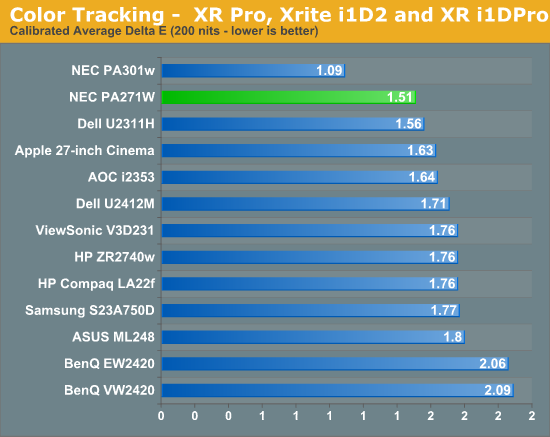
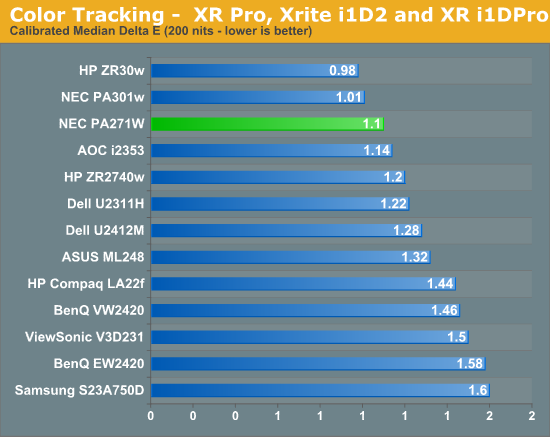
This is much better after a calibration, with an average dE of only 1.51 and a median dE of just under 1.1. You’ll notice the last color sample before pure white, a turquoise blue, has a much lower error here than on most displays. This is the shade of blue that actually lies outside of the sRGB colorspace and so most displays cannot reproduce it, leading to a very high dE there. The only panel to do better recently is the 30” NEC that has a true 10-bit panel.
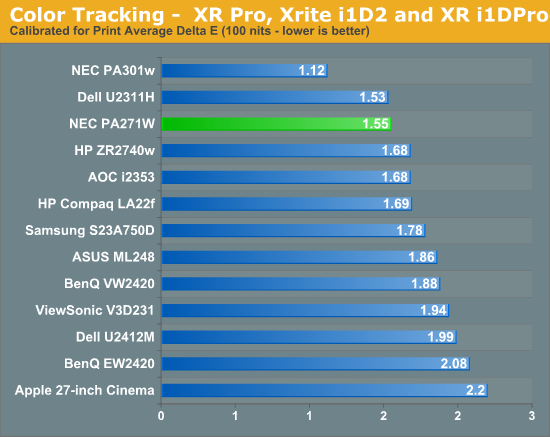
As the print market is a main area for NEC to target with this display, its performance with 100 nits of light output is of more importance than usual. Here we find that the NEC performs almost identically to its 200 nits results, which is actually quite good. As many displays get better or worse as the light output changes, that indicates they will only perform at their best at a certain light level, whereas if you are consistent the user can set the light to match their environment. The NEC doesn’t run away from the competition in any of these tests, but it performs very well, and very consistently.
You won't be lacking for gamut here either, as the NEC covers over 109% of the AdobeRGB gamut, meaning that for any work you are doing, even including something like DCI Cinema, the NEC has you covered.
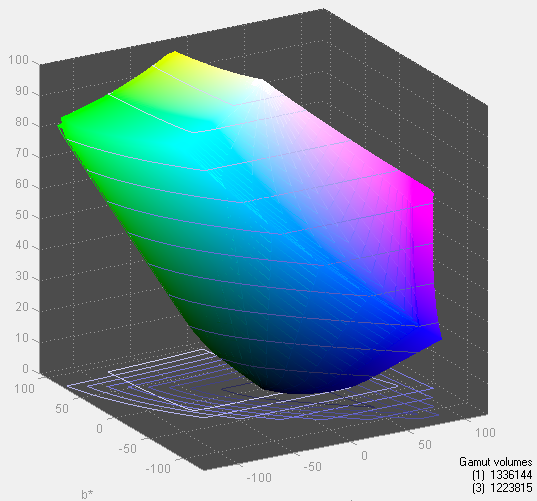



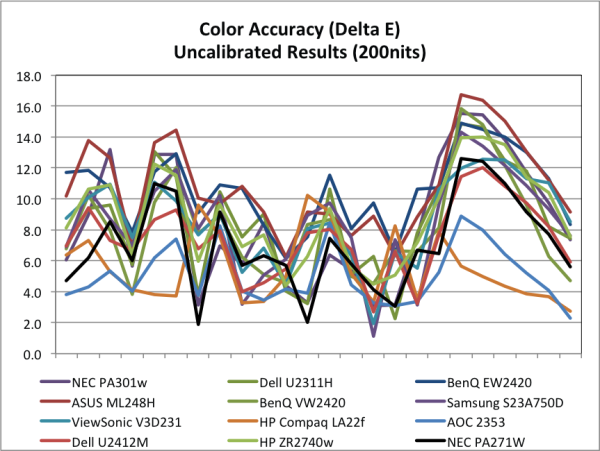
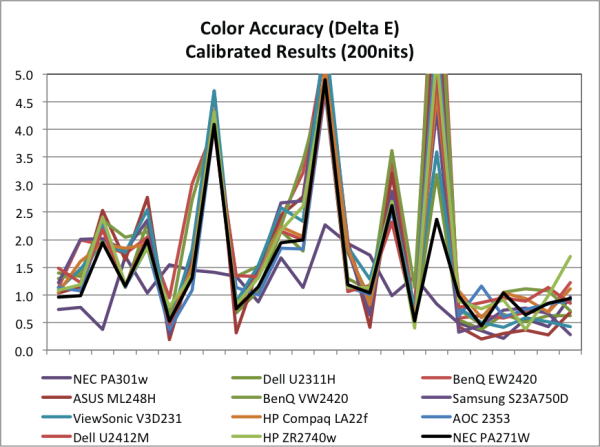
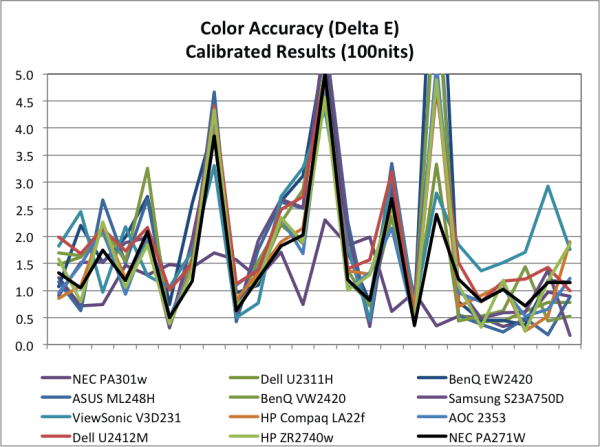








69 Comments
View All Comments
SlyNine - Tuesday, May 1, 2012 - link
CRTs had their own problems. Geometry not lining up, convergence. CRTs were far from perfect.Whats sad is manufactures completely abandoned the market. I would probably have been using CRTs up until this 120hz LCD if I actually had an option.
Dantte - Tuesday, May 1, 2012 - link
funny you say this. I'm still using a NEC FP2141 CRT as my main gaming monitor, but this is changing as of this week. I just ordered an Asus 27" 120Hz VG278H, I hope it doesnt disappoint.Sabresiberian - Wednesday, May 2, 2012 - link
Ugh I couldn't stand that monitor. 1920x1080 on a 27" screen? No way, those pixels are the size of a truck.That, of course, would probably be a different story at television viewing distance. At monitor distance? Not for me.
It's hard though; 2560x1440 and 60 Hz, or 1920x1080 at 120Hz? Frankly, I don't like either option very much. I'm used to 60Hz though, so I decided on 2560x1440 and bought a Dell U2711 (a few months before the HP was available). Let me tell you, as someone whose other monitor is a Sony GDM FW900 CRT, I'm very pleased with the U2711.
In my mind, the picture quality of the best CRTs still is overall better than the best LCDs, and I, like you, can only wonder at where they would be if development had continued. Still, I think the LCD has a better future, so I'm not complaining too much. I just wish they'd get on with building better quality ones (especially better refresh rates).
The main advantages, of course, are price and size. The Sony FW900 was $2500 back in the early 2000's, and 21-22" was about the limit, and it's hard for me to imagine we could have a high quality 27" or 30" CRT at a price I could afford (not to mention the weight of such a beast!). In a way, it was fortuitous that the CRT industry pretty much died, because I probably would never have been able to buy an FW900 otherwise. (I was able to get mine for about $700, refurbished and with a one year warranty, about 3 years ago.)
Size is a big factor, for me, and the reason I won't buy another CRT, even the fabulous FW900. There are of course other factors. I'm leaning towards a 30" for my next purchase - but frankly, again, I'm not happy with my options. Current 30" monitors have an acceptable pixel pitch, for me, but just barely, and it's really going to stand out since I have the better one in the 27" 2560x1440 format.
;)
Dracusis - Wednesday, May 2, 2012 - link
I have a Dell WFP2707 which is 27" 1920x1200, the pixel pitch is perfect for me, any smaller and I'd be leaning in too far to read things and wouldn't be able to "see" everything at once. IMO it's a better match than 2560x1440 and it's a lot easier to drive at native res for games - and with all the cheap shader based AA options now you really don't notice the pixels at all. Dot pitch is no bigger than the old 19" 1280x1024 displays. Generally IO'm about 2.5 ft away form my display when using it..Also, as a designer, pixels are my stock in trade so I kinda like being able to see them If I lean in close.
dragonsqrrl - Friday, September 27, 2013 - link
...wowIllegalTacos - Monday, May 14, 2012 - link
I have that monitor and I really like it. The pixels are large, as Sabresiberian said, but personally I am not bothered by it. I went from 60hz to 120hz so I was grinning at the fluid motion of dragging windows around. Since you're probably going to be playing 3D games, I'll just mention it's awesome. If you aren't on the Nvidia 3D forum, here's the link <http://forums.nvidia.com/index.php?showforum=209&g...I'd suggest Crysis 2, Battlefield 3, and Trine 2 for great 3D. The 3D vision forum does have plenty of suggestions though. I hope you enjoy it!
Also, I didn't get that weird oval effect a lot of people reported. Apparently ASUS fixed that with the new batches, but it's still best to keep an eye out for it.
<http://hardforum.com/showthread.php?t=1653278> Link to the relevant thread.
DanNeely - Tuesday, May 1, 2012 - link
Once mass market consumers and professionals abandoned CRTs there weren't enough users left to maintain production lines.Sabresiberian - Wednesday, May 2, 2012 - link
I think it was the other way around; the industry jumped on the LCD bandwagon and didn't even try to compete with the CRT. The general public was largely lead by the nose to make the change.;)
cacca - Wednesday, May 2, 2012 - link
LCD are the biggest Con/Swindle of the latest 15 years.So far we are not yet at the same level of the past CRT, you can imagine how crappy were LCDs at that time.
Basically they blackmailed reviews and created the myth of coolness for the LCD.
They were indeed thinner and lighter, really god send in this area, but utterly crap and pricey.
If they had put the same effort for the crt and short neck technologies... well we would had better crt, heavier but with no doubt superior to the LCD we have now.
JonScaife - Wednesday, May 2, 2012 - link
I had some nice CRTs considering my budget (Samsung 700IFT and Iiyama VM Pro 454 spring to mind) but I prefer my HP ZR24w now to any CRT I had then - for 1 simple reason - eye strain. I put it down to the flickering on CRTs, even at 100Hz on a 17" screen it would get me after a few hours. For the vast vast majority a "consumer" (i.e. cheap) 17 or 19" flat panel now is a huge leap from the 14 and 15" "consumer" CRTs they've replaced. Geometry was always an issue with CRTs too - and only gets tougher to do the bigger the screen gets. Just try looking at a PC display on a CRT TV, even an HD CRT TV (yes, they made them, I have one!) - the geometry is awful. Good geometry large size CRTs have always been like rocking-horse dung - and were priced accordingly.